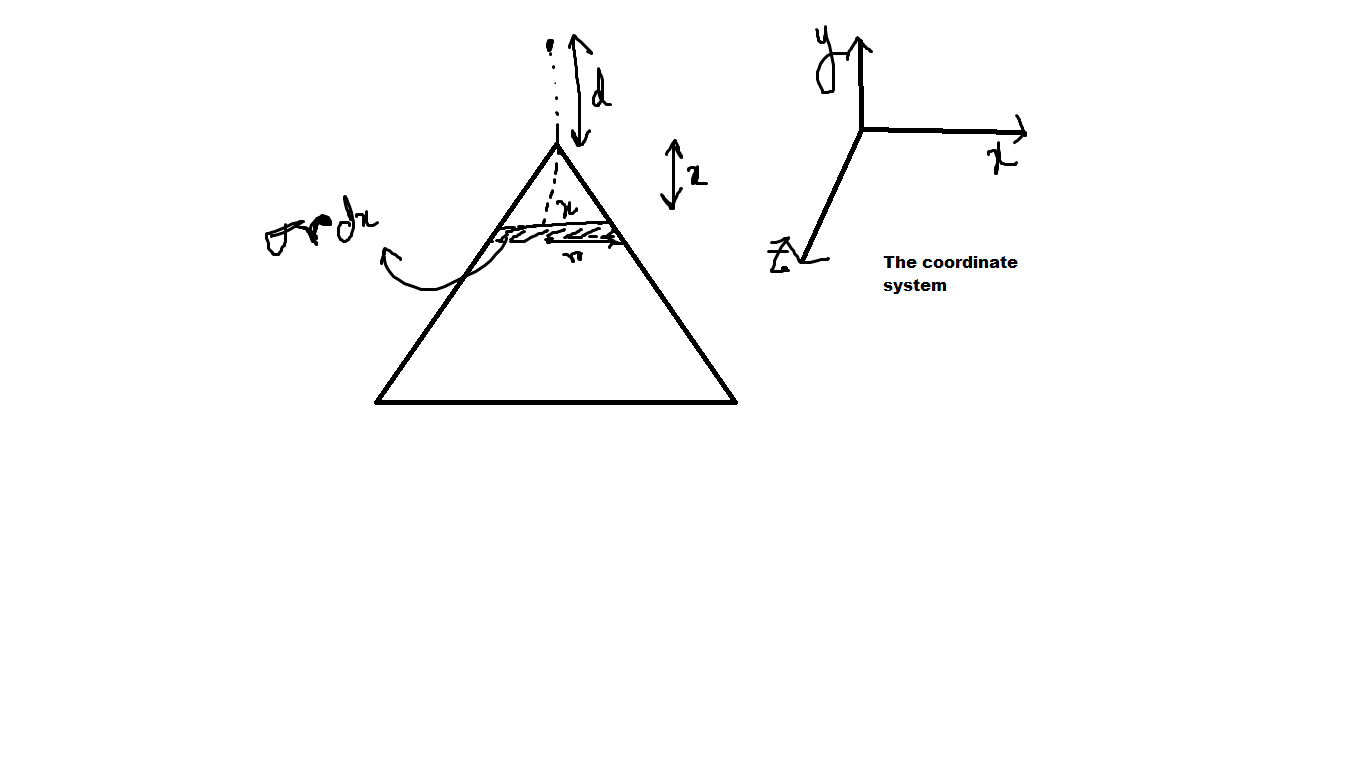Doubt on Ronak's Question.
https://brilliant.org/problems/electric-fields-due-to-different-kinds-of-plates/.
The link is given.
Here, while doing with Integration results in different value. I will be glad if someone points out where i am wrong.
QUESTION
We have a triangular uniformly charged plate of charge density .
We take a point just above a vertex of the triangular plate at a distance perpendicular to the plane of the triangle. Let the vertical component of electric field at that point be in
Find
Details and Assumptions:
1)
2) The triangle is equilateral. By vertical component of electric field I mean electric field perpendicular to the plane of charge.
3) The plate is non conducting.
MY SOLUTION

So By using Proportionality in triangle,
We get
.
Now for electric field, We have,
We also know .
After solving, we get .
If I am wrong anywhere, Please help me correct it. Also the integral calculation can be a error.
Thanks for looking through my doubt.
Easy Math Editor
This discussion board is a place to discuss our Daily Challenges and the math and science related to those challenges. Explanations are more than just a solution — they should explain the steps and thinking strategies that you used to obtain the solution. Comments should further the discussion of math and science.
When posting on Brilliant:
*italics*or_italics_**bold**or__bold__paragraph 1
paragraph 2
[example link](https://brilliant.org)> This is a quote# I indented these lines # 4 spaces, and now they show # up as a code block. print "hello world"\(...\)or\[...\]to ensure proper formatting.2 \times 32^{34}a_{i-1}\frac{2}{3}\sqrt{2}\sum_{i=1}^3\sin \theta\boxed{123}Comments
@Steven Chase @Mark Hennings @Thomas Jacob @Aaron Jerry Ninan @Ranajay Medya @Spandan Senapati .
Please help me! I may have skipped some names. You can add them too!
Log in to reply
I just solved it by integrating, with no simplifying tricks like the one given in the solution (ingenious as it is). I'll put up a solution in the next few days.
Log in to reply
That means my integral is correct, But the value isnt?
Log in to reply
I used an integral, but it wasn't necessarily your integral.
Log in to reply
Ohkay, I see. I dont know why, I am not getting it. Did you just saw my solution. You can point out any mistake if you get there. else it may be fine.
Log in to reply
When calculating the contribution from one of the strips, you have to integrate as well. So the problem effectively boils down to a double integral. But I did the two integrations sequentially.
Log in to reply
Okay, So I have to take a small element in that strip too?
Log in to reply
Yes. So integrating with infinitesimals within the strip gives you an expression for the contribution of a strip. Then integrating the contributions from the strips gives the final result. The first integral is readily done with an integral table. For the second integral, I used Wolfram Alpha. Then you have some interesting philosophizing to do regarding the limit of an arctangent before getting to the final answer.
Log in to reply
Okay, Will try in that way! Thanks!
Thanks sir! Finally solved it using Integrals! But, Why do i need double integral here? Why cant i apply integral from the middle of the thin strip in the triangle?
Log in to reply
Did you do it by integrating the contributions from the strips?
Log in to reply
Yes sir. Like the way you told
Log in to reply
Ok. And then it also takes an integral to figure out the contribution from a strip. That's why I refer to the whole process as effectively being a double integral.
Your way of writing fields due to an infinitismal element is wrong.Use a related result of finite length charged wire.E=dkλ(sinθ1+sinθ2) along the radial direction anddkλ(cosθ1−cosθ2) along the perpendicular. But if you want to develop your skills avoid integrals,symmetry helps a no of times,like considering hexagonal plates.
Log in to reply
I have a small qs. If does that 2ϵ0σ can be used for Any kind of plates? As i knew it is used for rectangular plates. Thanks
In this Q the concept of relative largeness plays a very important role. d->0 indirectly states that the point is near an infinitely large plane. I'll check if we can arrive at the same conclusion using the integration process.